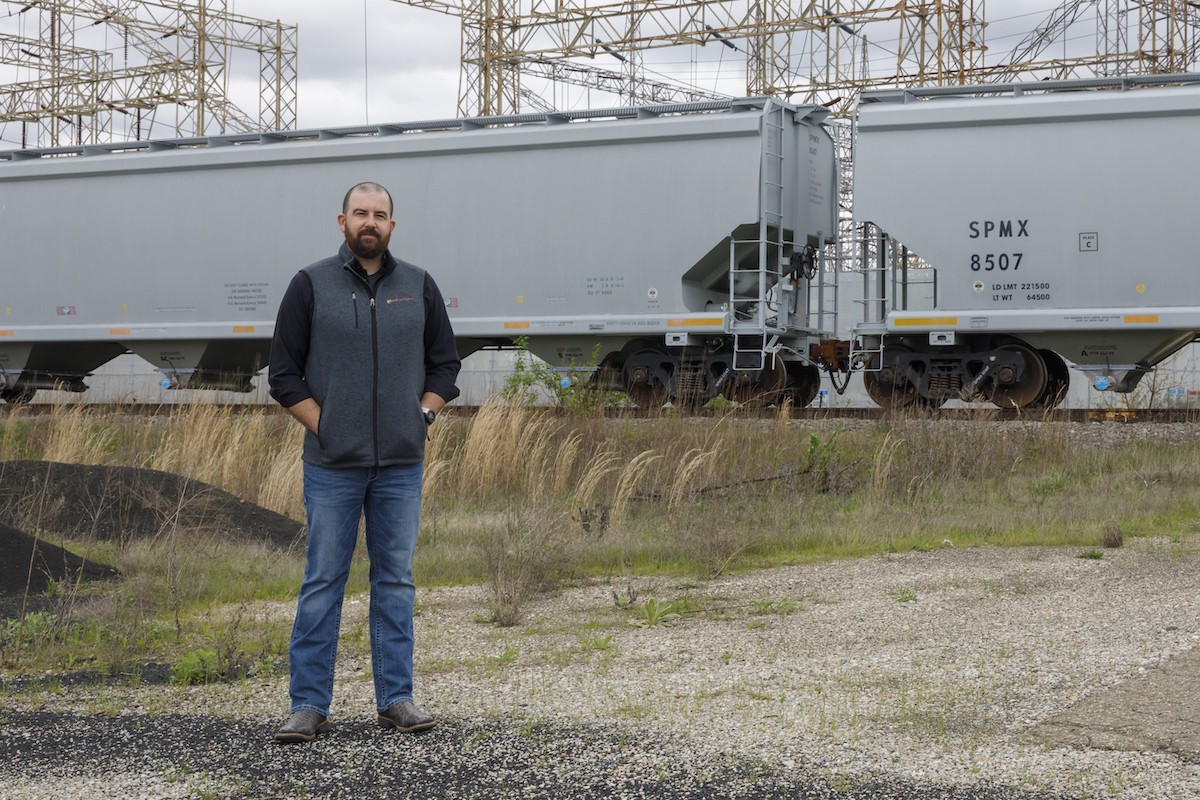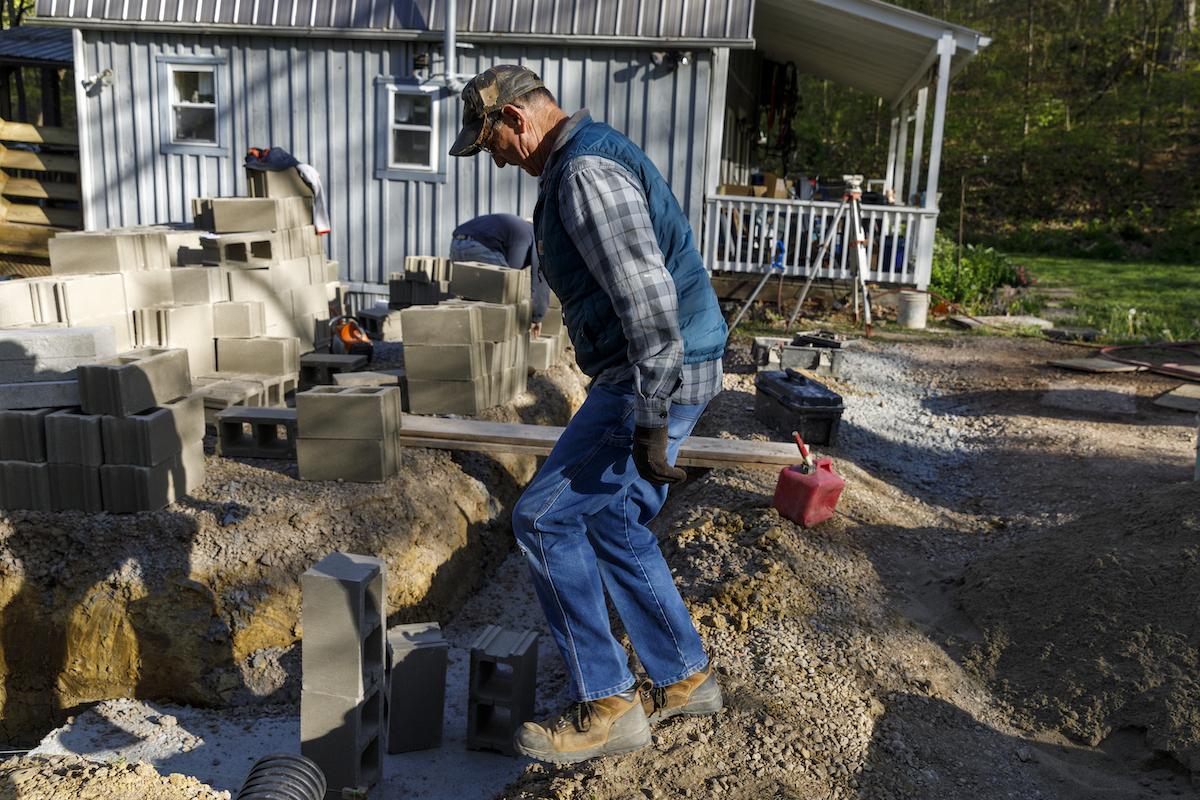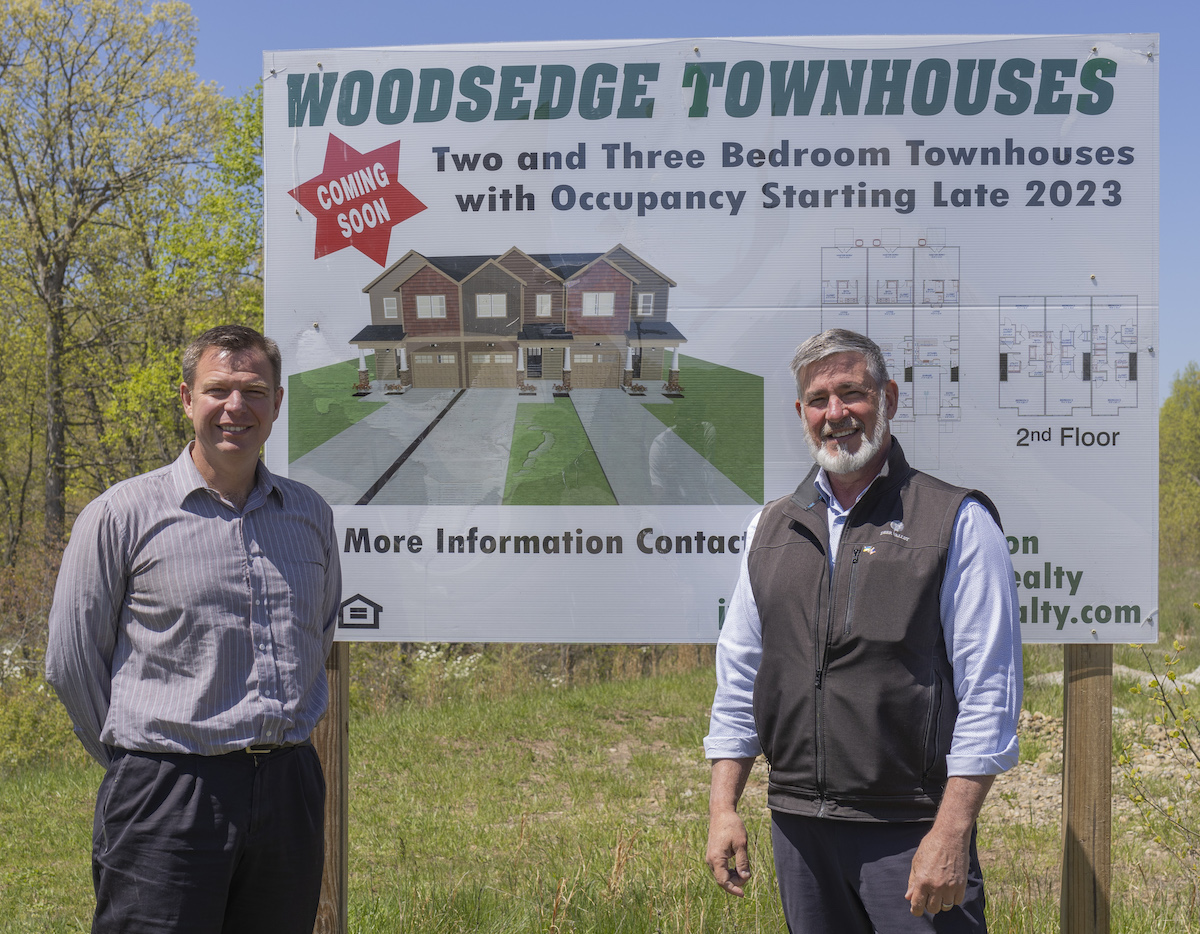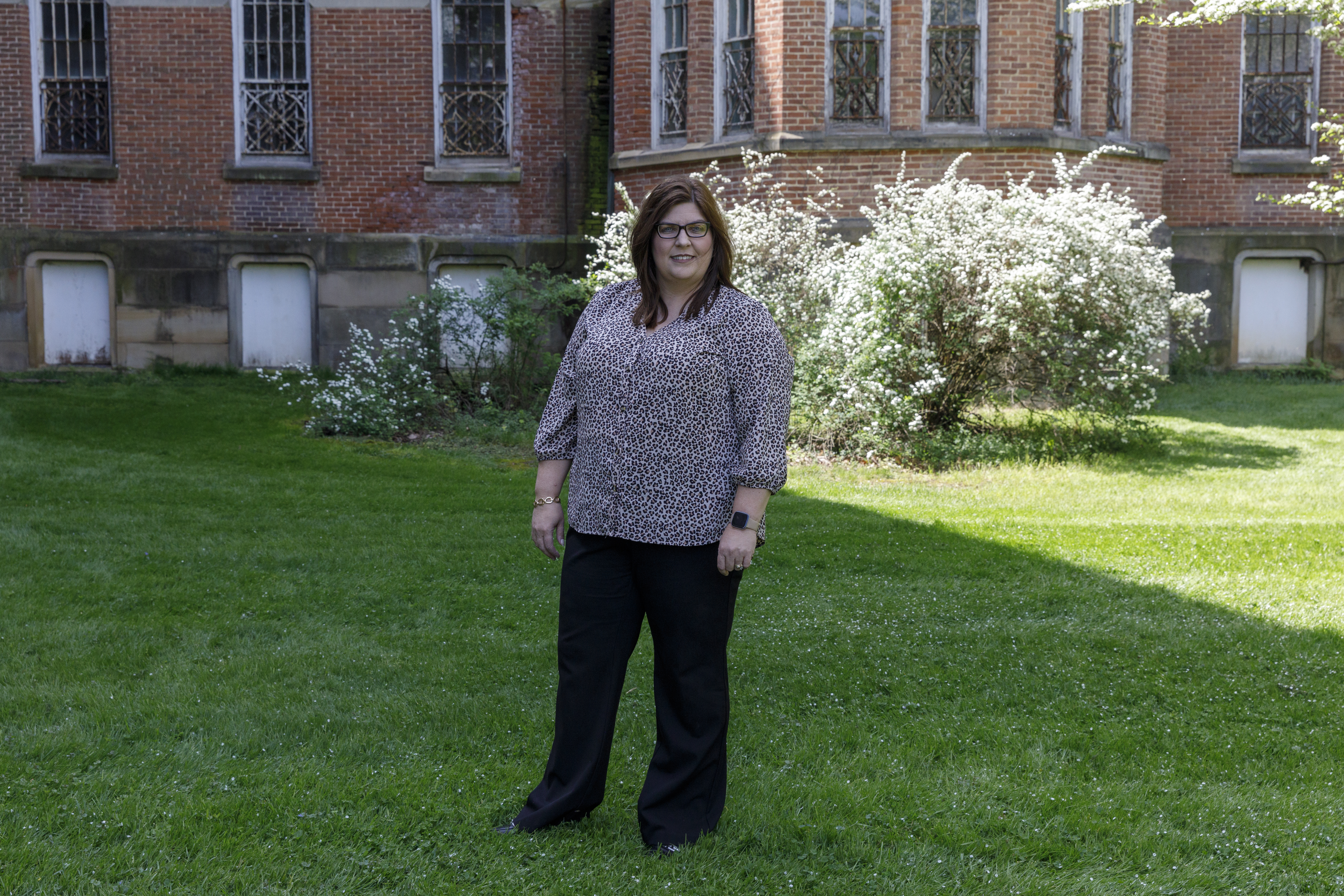
Jesse Roush is the economic development director for Washington County. In Marietta, the county seat, only one or two new homes are built each year, which makes it challenging for him to do his job. “If a gentleman comes in who’s representing a company that wants to build EV battery components and they want to invest 1.5 billion in a rural community and employ 1,200 people, that terrifies me,” he said. [Walker Smith | WOUB]
No vacancy: A severe housing shortage leaves little room for job growth in southeast Ohio
Economic development officials are passing on opportunities for business growth. Meanwhile, high costs for running infrastructure and public opposition to developments make it difficult to find buildable lots. “There is just nowhere ... to build homes," says one developer.

It’s usually the stuff of dreams for economic development officials: a company looking to invest more than a billion dollars to build a manufacturing plant for electric vehicle battery parts.
Representatives of the company were interested in a site in Marietta that was once home to a coal-fired power plant.
The site seemed like it might be a good fit. But there was a problem, and it was a deal breaker. The company planned on employing around 1,200 people.
“If a gentleman comes in who’s representing a company that wants to build EV battery components and they want to invest 1.5 billion in a rural community and employ 1,200 people, that terrifies me,” said Jesse Roush, executive director of the Southeastern Ohio Port Authority, the economic development agency for Washington County.
“Another example is somebody who wants to come in and invest $750 million and employ 500 people. That still terrifies me.”
It terrifies him because Marietta and the surrounding communities in Washington County lack housing for a large influx of employees — or even a small one.
Roush said about one or two new homes a year are built in Marietta, which is the county seat and its largest city.
This shortage of housing is a problem throughout southeast Ohio, throughout the state, and across the country. Housing experts say construction of new homes in Ohio is falling farther and farther behind the need every year.
This presents a serious challenge for local economic development officials like Roush, whose job is to promote business growth. They find themselves passing on one opportunity after another because they do not have the housing for all the employees these businesses would need to hire.
With so little housing available for newcomers, a large employer moving into the area would be mostly limited to employees available locally.
“What the reality is, is they’re going to suck employees away from other local businesses, which leaves an employment gap at other local businesses, which we still won’t be able to fill because we can’t recruit people, because we don’t have places for them to live,” Roush said. “And we’re the snake eating its own tail at that point.”
In the face of this housing shortage, economic development officials are seeing a shift in their roles. They used to just worry about growing business and creating jobs, which is challenging enough. Housing took care of itself.
“They were attracting businesses, they were building industrial parks, doing those kinds of things and just assumed that the community would develop along with them,” said Chasity Schmelzenbach, executive director of Buckeye Hills Regional Council, which promotes economic development across eight counties in southeast Ohio. “That was the philosophy. Today’s philosophy isn’t so much like that.”
Instead, economic development agents and other government officials increasingly find themselves in the unfamiliar role of trying to figure out how to get more housing built.
“The communities in southeast Ohio that grow are going to be the ones that develop housing,” said Perry Varnadoe, the economic development director for Meigs County. “I’ve been doing this for almost 30 years. That’s what I see now, and that’s a new paradigm. That’s where we’re going to grow. It’s not jobs, it’s housing.”
When people talk about why homebuilding is falling so far short of the need, they often focus on costs: for building materials, land and labor. These costs all soared during the pandemic and remain much higher than they were before. High interest rates also have driven up the cost of building homes.
Rising construction costs certainly are impacting housing development, especially when it comes to building affordable housing. But they’re only part of the story. Construction of new homes in Ohio has been sluggish since long before the recent runup in costs, starting with a big drop after the housing market collapsed in 2007 and triggered the Great Recession. Housing starts have been on a slow recovery since then, even as the broader economy picked up steam, and are still nowhere near where they were before the collapse.
Enzo Perfetto, a third-generation homebuilder in northeast Ohio and president of the Ohio Home Builders Association, points to another obstacle to home construction, and one that is going to be much harder to get around.
“I think the biggest problem that builders are facing not only in Ohio, but I think pretty much throughout the United States, is the availability of buildable land. In other words, if I get in my pickup truck after this conversation and I decide I’m feeling great about the economy, I’m feeling great about the future, and I want to build a spec home for a potential customer out there, because I know this house will sell overnight because there is such a pent up demand. There is literally nowhere to build this house. … There is just nowhere, at least in our neck of the woods, to build homes.”
And in southeast Ohio, even when buildable land can be found, there are few homebuilders left to do the building.
A shift in focus
Varnadoe will drive out to construction sites and strike up a conversation with the project foreman. He’s there to make a pitch: The market for housing is strong. Why not strike out on your own and become a homebuilder?
It’s the same approach he used to take to recruiting businesses.
“We used to call it smokestack chasing,” he said, “where you go to a company, you try to convince ’em to expand here, to come here. … We’re doing the same thing now to housing developers trying to entice them to build here.”
He used to focus on bringing jobs to the county, one of the poorest in the state. But he’s not so focused on jobs right now. What he needs are homes.
“It’s one of the biggest paradigm shifts I’ve seen in many, many years of going from the importance of jobs to the importance of housing,” he said. “Jobs are always important, but right now in our communities there’s as many jobs for the most part as there are people. It’s not the pressing issue that it has been for many, many years past in rural Ohio.”
“Right now, our biggest issue … is finding suitable housing for folks of all ages, all demographics, all income levels,” he said. “There is a tremendous shortage due to, for many years, a lack of new building in the region.”
The interplay of housing and business growth is a classic chicken-and-egg scenario. Which should come first: Build homes and the businesses will come, or bring in businesses and the housing will follow?
In southeast Ohio, the focus has long been on business growth. The collapse of the coal industry decades ago left much of the region without much of an economic base. People who grew up here, especially recent high school or college graduates, were leaving the region for better opportunities elsewhere.
Housing was not the pressing issue. But the housing shortage has now become so critical that it’s a serious limitation on business growth.
Mollie Fitzgerald said she doesn’t bother following up on many of the leads she receives from the state about businesses looking to expand. There’s no point if there’s not enough housing for the employees these businesses would bring.
“I won’t even submit even if I have the perfect site, for that reason,” said Fitzgerald, executive director of the Athens County Economic Development Council.

Mollie Fitzgerald, the economic development director for Athens County, said she routinely passes up on opportunities to recruit businesses because of the housing shortage. “It does complicate my job,” she said. “It makes it harder to attract and retain companies when you can’t assure them that they’ll have a place to live.” [Shamar Semple | WOUB]
The lack of housing doesn’t just constrain efforts to recruit new businesses to the region; it affects existing businesses in ways they may not even recognize. Demand for housing in the face of the shortage has driven up home prices to the point where even middle-income earners are finding themselves priced out. And even those who can afford a home sometimes struggle to find one.
“I don’t know if they really realize that that’s the impact that this housing shortage is having on their businesses,” said Schmelzenbach of Buckeye Hills Regional Council. “They just realize that they can’t find workers, they have to pay them more than they’ve had to pay them before. Some of that is so that they can afford to live in whatever their new housing situation may be or for the increase that it costs them to be able to commute. So I think in some cases it’s a little bit of a hidden problem when existing employers think about an expansion or something like that.”
It’s also a loss for the community when employees end up living somewhere else and commuting in for work.
For example, three years ago Marietta company Farrar Scientific was acquired by Trane Technologies, a global manufacturer of heating and air conditioning equipment. Trane sent six executives to work at Farrar, said Roush, the Washington County economic development director.
Four of them gave up on trying to find a home in Marietta and ended up buying across the Ohio River in West Virginia, he said. This means most of the economic impact of creating those positions will be lost.
“They’re out of city limits, so they’re not paying city income tax, they’re not paying real estate tax,” he said.
This is the same reason Fitzgerald says she’s reluctant to recruit businesses to Athens County if there’s not enough housing for their employees. The businesses might be willing to locate in the county and hire workers from outside the area who are willing to commute. But the community loses out on crucial tax revenue.
Fitzgerald said she’s starting to have conversations with her board about whether they should expand their mission beyond traditional business development to include housing.
“It is an issue that I’m withholding properties for leads that could be very fruitful and expand the tax base and living-wage jobs,” she said. “We don’t even go for it because it’s the housing issue.”
“Is it my job to fix it?” she asked. “It does complicate my job. It makes it harder to attract and retain companies when you can’t assure them that they’ll have a place to live.”
Not enough builders
But any effort to fix the housing shortage will require addressing something else that is in short supply in southeast Ohio: homebuilders.
Many of the homebuilders in the region are people approaching their retirement years, and there are relatively few younger people getting into the business to take their place. Some of the older builders were already scaling back before the pandemic, and then during the pandemic some decided to call it quits.
“We have two builders who are under the age of 50 with incredibly limited capacity. That’s it,” Roush said. “Everybody else is 65 or older and has gotten out of it, or they have determined that they can build decks, put on roofs, do renovations and be just as lucrative in their business model because not only do we not have enough new homes, but we have an aging inventory that requires a lot of attention.”
Roush said he asked one prominent homebuilder why he’s no longer building homes anymore.
“His response is, ‘I only have to teach people how to do roofs,’” Roush said. “‘Then we do three or four of ’em a week and we make plenty of money, and I don’t have to worry about subcontractors not calling me back or not representing my brand in a proper way. I just get a group of guys, I train ’em how to do roofs, and we just do roofs.’”
This shortage of homebuilders in southeast Ohio is compounded by massive construction projects in central Ohio and in West Virginia along the Ohio River that have been a giant vacuum for labor.
“Intel is wonderful for Ohio. Intel is wonderful for the country from a national security perspective. It’s critical we make chips again in the United States,” Andy Stone, service-safety director for the city of Athens, said of the Intel chip plant under construction in the Columbus area. “That project is just sucking so much … of the skilled labor in the state of Ohio and the materials in the state of Ohio and all of the surrounding projects in support of that. And it just causes a shortage in people who can do that work.”
Varnadoe, the Meigs County economic development director, mentioned a local housing developer who could build a 1,600-square-foot, two-bedroom, three-bathroom home in the county that would sell for around $279,000 to $299,000. He could build the same home in Licking County, where the new Intel plant is being built, and sell it for around $449,000.
“So the business model is certainly that’s where he’s going to go build. And more and more of those folks are looking there,” he said. “Not that there’s not a need here and not that there’s not an incentive for profit, but the need and the profit are so much better in areas close enough to us where they can go to.”

Perry Varnadoe, the economic development director for Meigs County, says he is more focused on housing than bringing in jobs. “The communities in southeast Ohio that grow are going to be the ones that develop housing,” he said. “It’s not jobs, it’s housing.” [Shamar Semple | WOUB]
About 40 miles down the Ohio River from Varnadoe’s office in Pomeroy, Nucor is building a multibillion-dollar steel mill on the West Virginia side, another huge draw for construction workers to build the plant and the homes that will be needed to house the hundreds of people who will work there when it’s completed.
This shortage of local homebuilders comes just as Meigs County is seeing an uptick in demand for housing.
“We are short of housing in low income, moderate income, high income, in every possible income category,” Varnadoe said. “Our local realtors will tell you that they have multiple offers for virtually every house that goes on the market in every income range. And that’s something new to our region, where homes would sit on the market for a long time. They’re going so quickly.”
Some of these buyers are coming to Meigs County for housing because of the big development projects across the river in West Virginia, Varnadoe said. Others are relocating from other parts of the state to start a business, work remotely or retire, an unusual situation for counties in southeast Ohio that are more accustomed to people leaving for better opportunities elsewhere.
While home prices in southeast Ohio are rising, and becoming out of reach for many local residents, they are still significantly cheaper than in the state’s metropolitan areas. Some recent buyers are paying cash for their homes in Meigs County with the money they pocketed from the sale of their homes elsewhere, Varnadoe said.
This surge in demand, coupled with the inability to get much new housing built, puts a strain on supply that drives prices even higher.
And all of this explains why Varnadoe is out scouting for new homebuilders. But he hasn’t had much luck so far.
With so many big construction projects underway elsewhere, there’s plenty of work to be found and plenty of money to be made working for someone else and little incentive for people in the construction trade to risk striking out on their own given the high startup costs.
“I’m convinced that’s going to work eventually, but the problem right now is interest rates are so high,” Varnadoe said.
Roush agreed. He said he’s a perfect candidate to become a homebuilder.
“I’ve been around sites and infrastructure development my whole life, laid out subdivisions,” he said. “I have the aptitude to be able to jump in and build homes, but I’d have to start with a lot of debt and build four or five homes in the first year to even think about coming close to replacing my current salary.”
“There are a lot of people like me who probably could go do this,” he said, “but they’ve got great jobs already. Why take the risk at seven and a half or 8 percent interest and the need to have to build several units, which could take a year. And if you can’t swing the hammer or run the wire or plumb the pipes and you got to hire subcontractors, you just opened yourself up to a whole lot of liability because, guess what, there aren’t any great subcontractors left either.”
This shortage of subcontractors — plumbers, electricians, heating and air conditioning technicians — is another big obstacle to getting housing built. Some of this is also the result of big projects sucking up so much of the labor. But skilled labor was already in short supply because of a much longer trend: For decades, students in high school have been encouraged to think about college, not a career in the trades. Many high schools stopped offering classes that prepared students for this line of work or at least got them thinking about it. The housing market collapse in 2007 and the Great Recession that followed further discouraged an entire generation of young people from going into construction.
Meanwhile, many people in the skilled trades are now edging closer to retirement, with far fewer people coming up behind to take their place. Some schools are now trying to funnel more young people into the pipeline by reintroducing courses in the construction trades, but it’s going to take years to rebuild the depleted workforce.
“Construction is one of those industries that you learn over time. … You can’t just take me on day one and say, go rewire this building. I need a two- to three-year program, so I actually don’t electrocute myself,” said Jennifer Gorsuch Walters, president and CEO of Fairfield Homes in Lancaster. “And this is an industry where we need lots of scaffolding of experience. You want someone young in the industry working with someone who’s been around for a long time because there’s not a great playbook on everything. So there’s learning by experience.”
In the meantime, the demand for skilled workers is driving up labor costs.
High construction costs
In early September 2023, the Athens Planning Commission was set to hold a public hearing on a proposed development intended to bring some much-needed affordable housing into the city.
Instead, the city’s mayor opened the meeting by announcing that the project, five years in the works, might be dead.
The estimated cost of running basic infrastructure — roads and sidewalks, water, sewer and electrical lines — to the lots was three times what had been budgeted. The project no longer penciled out, even with the tax incentives the city was offering to make the development work.
Rising construction costs — for materials, labor and land — combined with high interest rates are the usual culprits cited to explain why homebuilding is lagging so far behind demand and why it’s so difficult to build homes an average wage-earner can afford.
Ron White, a second-generation Athens County homebuilder, said that just a few years ago he could build homes for middle-income families. Not anymore.
Before the pandemic, it cost about $135 a square foot to build a modest home in the county, he said. That same home today would cost at least $175 a square foot, and more likely closer to $200. This doesn’t include the cost of the lot, and prices for bare land have also soared over the past few years.
White said that across the board he’s paying about 25 to 30 percent more for building materials than before the pandemic. This includes concrete and anything made of steel or plastic, including roofing, siding, windows and gutters. Prices for plumbing and electrical supplies also are much higher.
It’s also taking longer to get certain materials, which causes delays.
“Every manufacturer I deal with — my window suppliers, siding suppliers — all those people are telling you, ‘I need six weeks now to get your windows or eight weeks or 10 weeks. I just don’t have enough people in my plant,’” White said.

Ron White, a second-generation Athens County homebuilder, said just a few years ago he could build homes for moderate-income people. Not anymore. Costs for building materials, labor and land have gone up significantly. Another significant expense is running basic infrastructure — roads, drains, and water, sewer and electrical lines — to the building sites. [Walker Smith | WOUB]
The price fluctuations and supply issues make it difficult for builders to bid jobs. And if the builder is financing the project with a construction loan, the longer the project takes to complete, the more payments they’re making at high interest rates.
“So contractors are losing money because they bid a job at X and now they can’t get their materials, and the material — I mean, lumber was a going up every single day, and in the past, you could wait until it came back down, but nothing was coming back down,” said Gorsuch Walters of Fairfield Homes. “So people’s margins were really getting squeezed, and some of the small contractors were struggling finishing jobs.”
White said he’s also paying 20 to 25 percent more for labor than before the pandemic.
“And I am doing that just to keep my guys. I don’t want to lose ’em,” he said.
Losing them is an ever-present threat given the labor shortage.
“I had a couple different people in the area that were trying to steal some of my guys,” White said. “And I went home one day, I told my wife … this guy’s trying to steal one of my guys and he knows two of ’em, so he might try to steal ’em both. I said, let’s give ’em a raise where they want to stay here. … So we did, and that was pretty good for about the first six months of COVID. Well, then it started happening again.”
High construction costs not only make building a home more expensive, they also increase the cost of creating a buildable lot in the first place.
This is the obstacle the city of Athens ran into with its project. And it will likely present the biggest challenge to any efforts by communities in southeast Ohio to simply build their way out of the housing shortage.
“If I go to a constituent of mine and I would say, what’s the one thing holding you back from building a home? They’re probably not going to say, well, lumber’s creeped up a little bit, or my plumber’s charging 5 percent more. They’re probably going to say, we have nowhere to build a home,” said Enzo Perfetto, president of the Ohio Association of Home Builders.
Perfetto’s point is the cost of building homes fluctuates over the years, but this is something builders can adapt to. It may mean building homes that are more expensive than average wage earners can afford, but they can still build homes. He said when got into the business in the early 1980s as a third-generation homebuilder, interest rates were around 18 percent. So today’s rates don’t faze him and in fact, he said, are much closer to normal than the historically low rates from a couple of years ago.
What keeps builders from building enough homes to meet the demand is a lack of buildable lots, Perfetto said. And by buildable lots, he doesn’t mean open land that might be suitable for development. There’s plenty of that in Ohio. What he’s talking about are lots where the steps have been taken to make building possible. This includes having the basic infrastructure in place.
It also includes getting support from the community. And this increasingly has become one of the biggest obstacles for homebuilders throughout the state, Perfetto said. He described a typical scenario:
“You take that piece of land and you get it under contract with the landowner, and then you go to your civil engineer and you do a beautiful subdivision, reasonably done, not super high density, but something that will fit the character of the neighborhood. And you take into consideration wetlands and things of that nature. And I hate to simplify this, but nine times out of 10, that’s when the roadblocks start popping up. You’re probably going to get the locals coming by saying, ‘Boy, I just don’t want that in my backyard. You’re going to increase traffic flow. You’re going to contaminate the groundwater. You’re going to put an undue impact on the school system. Have you talked to the fire department? They don’t have enough manpower to service the development.’ These are all the hurdles that we expect, and we get through each one of these and then, through their legal rights, if they just don’t want it — they don’t have to have a reason — if they just don’t want it … they get on the referendum and they can just vote it out for no other reason than they just don’t want it.”
Homebuilders are used to dealing with a certain amount of opposition to proposed developments and making concessions and compromises to satisfy the concerns of local officials and residents. This has long been the case with low-income developments.
Perfetto said he hears from builders who say they face increasingly hostile opposition to housing developments of any kind. It’s not just that residents are wanting changes to projects to address concerns they have. They like their neighborhoods and communities just as they are and don’t want any change.
It’s an extreme form of the not-in-my-backyard mindset, Perfetto said. He has experienced it himself. He said the level of vitriol he and other builders face at city council meetings and other public forums has risen sharply in recent years, with people screaming at them, calling them names and threatening them.

Enzo Perfetto is a third-generation homebuilder and president of the Ohio Home Builders Association. He said homebuilders increasingly face opposition from residents who don’t want more housing developments in their neighborhoods or communities. [Photo provided by Enzo Perfetto]
Perfetto mentioned a project he proposed for a vacant 40-acre parcel zoned for industrial use not far from the neighborhood where he lives in northeast Ohio. His proposal was for a multigenerational development with 500 units that would include starter homes, larger move-up homes for growing families, and assisted living units for seniors ready to transition out of living in their own home.
“So if you’re inclined, you can stay in the development literally your entire lifespan or bring mom and dad into the neighborhood because they don’t want to live in their house anymore, and you can go drive a golf cart over and go visit them,” he said.
“We got the entire council on board, the mayor was on board,” he said. “Everybody loved it. They said this is phenomenal for the community. It’s what we need.”
But some people who lived close to the site opposed the project, he said, and started a campaign against it saying it was going to be low-income housing. Perfetto said he suspected they simply didn’t want any development on the property — they liked the open space and wanted to keep it that way.
“And so they brought the issue to the referendum and we actually had to go on the ballot and it became very ugly,” he said. “It became very personal attacks on who’s going to live there and so on and so forth. And long story short, it got defeated in the election.”
This was 10 years ago, and the property is still vacant, he said.
“How do you overcome someone who says, ‘I don’t want this development in my backyard, and then they have the legal right to bring it to a referendum and it gets voted on?” Perfetto asked.
Perfetto acknowledges that as a homeowner himself who lives in a quiet neighborhood with large lots on the outskirts of town, he can appreciate the concerns of those who don’t want new developments around them and want to preserve the open spaces that drew them to the area in the first place.
One alternative is to do more infill development in the cities and suburbs. But these projects also run into community opposition along with zoning codes that may not allow for homes to be built on the smaller lots available, or don’t allow unused commercial spaces to be converted into housing.
Perfetto said opposition to new projects in his area has become so strong that he’s changed his business model. He no longer tries to build homes on undeveloped land. Instead, he buys older homes in established neighborhoods that he can get for a good price, then tears them down and builds new homes he can sell at a profit.
A lot of builders are doing this now, he said. But it isn’t doing anything to address the housing supply problem.
“It’s really our only way of surviving, to stay in business, because there is no available land to build on,” he said.
A heavy burden
Community opposition is less of an issue in southeast Ohio, said Varnadoe, the Meigs County economic development director.
“Folks actually want housing down here,” he said. “They want places where their kids can grow up and live and be close to home.”
The main obstacle to creating more buildable lots in this region, Varnadoe and other local officials said, is the cost of running infrastructure, the issue that ground to a halt the proposed housing project in Athens.
That project came about because city leaders recognized that if they were going to get affordable housing built, they were going to have to take the lead.
Mayor Steve Patterson said when he started with the city 20 years ago, growing the housing stock was not something city officials thought much about. They were focused on traditional municipal functions like maintaining streets and providing police and fire protection.
“The market was there for developers to go and make money by building housing,” Patterson said. “And now, because the market isn’t working correctly for that, city officials are having to figure out creative ways to make this happen.”
In 2018, Patterson and other city leaders began working on a development proposal that featured attached townhouses in an effort to make the housing more affordable. The city partnered with a local developer and offered tax incentives to help the project pencil out.
As construction costs rose during the pandemic, so did the prices for the proposed townhouses. By the time the project was coming before the city’s planning commission for consideration, the starting price was around $240,000.
Affordable is a relative term, but this clearly put the homes beyond the reach of the city’s average wage earners. City officials reasoned, however, that just adding more housing stock, even at a higher price than what was initially envisioned, would help ease some of the upward pressure on home prices.
“I mean straight up economics, right?” said Andy Stone, the city’s service-safety director. “Scarcity drives up cost. And so if you can increase supply, you can drive down the cost of homes across the board. So that was our thinking in this particular thing. We were creating a development of homes that were not necessarily affordable for a certain demographic but weren’t $700,000 homes either, and a middle-class couple could probably get a mortgage to be able to pay for that, number one. Number two, they can build equity and that’s in short supply here.”

Andy Stone, the service-safety director for the city of Athens, and Mayor Steve Patterson stand at a sign advertising a housing development years in the works that has ground to a halt because the cost of running infrastructure to the lots is so high the project no longer pencils out for the developer. [Shamar Semple | WOUB]
With the project now on hold because of the much higher than expected infrastructure costs, city officials are looking for a way to salvage it.
Under the project as proposed, the developer was going to run the infrastructure and then turn it over to the city to maintain. One option is for the city to pay for the infrastructure in order to build some profit back into the project for the developer. It applied for grant funds from the state to help cover the cost but did not receive any.
“The traditional model was the developer builds the infrastructure, turns it over to the local government and builds the housing and sells the housing, and their costs are low enough that they can still make a profit. And so the incentive was there to do that,” Stone said. “The incentive isn’t there to do that any longer for them.”
“We’re almost having to turn the traditional model on its head for development because of the fact that the return for the developer isn’t there,” he said.
The city also could use money already in its infrastructure budget to get the work done. But this money is intended to be used for work on existing lines.
“And so you make a priority decision about, do I spend $2 million to extend water and sewer outside of the city when I’ve got 80-year-old lines in the city?” Stone said. “The responsible thing to do is probably to replace those, but you also got to grow too in order to alleviate some of the pressures you have on housing. And so it’s this challenge of priorities and how do you do both things? That’s exactly what we’re looking at.”
Communities throughout southeast Ohio face a similar challenge.
“If you get very far outside of our individual cities and a few of the villages, the infrastructure isn’t there to support a multifamily or a housing complex,” said Schmelzenbach of Buckeye Hills Regional Council. “So not only do you have to worry about building the house, you have to worry about building out the infrastructure to support it. … And it’s not particularly attractive to a developer to come to the rural part of the state and have to pay completely to do all the infrastructure extension, all the land development and build the housing.”
It’s not attractive because the housing projects in southeast Ohio tend to be small. In larger metropolitan areas with bigger housing developments, a developer can recover the infrastructure costs through the sale of more homes. This is much harder to do with just a handful of homes.
White, the Athens County homebuilder, mentioned a 10-acre lot in the Albany area that was priced at $150,000. Running infrastructure to the property would cost another $200,000 to $250,000, he said. So he’d be in $400,000 before even breaking ground on a house. He can’t afford this initial investment, and even if he could, he’d have to add so much to the price of the homes to recover this cost that they would likely be well out of reach for many people in the area.
The small communities that dot the landscape of southeast Ohio don’t have the means to pay for the infrastructure either.
Varnadoe, the Meigs County economic development director, said there’s plenty of land on the outskirts of Pomeroy and Middleport, two villages along the Ohio River, that is suitable for development. But without the funds to pay for infrastructure, the communities might have to turn to their residents for help, which may mean higher taxes.
Varnadoe said he recently met with the mayor of Pomeroy, who’s looking at expanding water and sewer just outside the village limits to encourage housing development.
“And his issue is, I don’t know if we can afford to do it, because I don’t know if I can make my local residents pay for water and sewer expansions outside of the village that they’re not going to see the benefit of,” Varnadoe said. “And that’s where the state can come in and help tremendously.”
Help from the state?
Decades ago, state leaders realized that if southeast Ohio was going to build a post-coal economy, it was going to need some help. A program was created that provided funding for communities in the region to build industrial parks so businesses had a place to locate that they didn’t have to build themselves.
The program was a success, Varnadoe said. Now he and other community leaders in southeast Ohio would like to see the same thing happen with housing: some kind of funding from the state to pay to expand infrastructure and create more ready-to-build lots.
This idea often meets with some reluctance because housing doesn’t fit the traditional definition of economic development. But local officials argue that building more housing is economic development.
“If an economist were to sit down and evaluate the loss of opportunity, the loss of jobs, the loss of revenue that we’re experiencing in the absence of proactive housing development, it would be startling and significant,” said Roush, the Washington County economic development director.
More housing will help expand the local workforce, which is a top concern for businesses already operating in southeast Ohio, said Fitzgerald, the Athens County economic development director. Also, with more housing available, she and her counterparts in other counties could start pursuing some of the opportunities to recruit new businesses to the region that they’re passing on now because they don’t have the housing stock.
More housing also means more residents paying sales, income and property taxes.
“Once you build a house, it’s going to be there for a long time,” Varnadoe said. “A company may leave in five years, but once you have that house, you’ve got residents and tax revenue that’s almost guaranteed. … It’s a good long-term revenue generator.”

Chasity Schmelzenbach, executive director of Buckeye Hills Regional Council, said solving the housing shortage is going to require the same kind of effort that was put into economic development. “We’ve worked very hard on building an ecosystem and a formula for how you do economic development,” she said. “We need to do the same around housing.” [Walker Smith | WOUB]
State leaders are taking steps to address the housing shortage. The two-year state budget passed last year included $150 million in grants and tax credits to assist with construction of new homes or rehabilitation of existing ones. The state also created a tax credit program specifically to promote construction of single-family homes and allocated $50 million a year over four years to fund it.
At most, these programs will help fund the construction or rehabilitation of a few thousand homes throughout the state. It’s unclear how much of an impact these programs will have in southeast Ohio. Local officials say the scoring criteria for highly competitive programs like these often make it difficult for small, rural communities to compete, not to mention the costs they will have to incur even with the assistance, which may result in the projects still not penciling out.
Schmelzenbach of Buckeye Hills Regional Council said solving the housing crisis is going to require the same kind of focused, comprehensive and sustained approach, involving partnerships in the public and private sector, that has been applied to economic development. Organizations traditionally focused on promoting business growth may need to expand their mission to include housing development, she said. New organizations may be needed that just focus on housing.
“We’ve worked very hard on building an ecosystem and a formula for how you do economic development,” she said. “We need to do the same around housing.”
“We have to apply the same type of effort and education that we did to try to bring companies in. We have to apply that same effort and education to redevelopment of our communities and our housing stock,” she said. “It’s not going to be easy and it’s not going to be fast, especially here in the rural areas. But we have to start. We can’t keep sitting and just saying, ‘Hey, we don’t have enough housing. We don’t have enough housing.’ We have to start building the ecosystem back to build housing.”
